Introduction:
Telecommunications and information systems, both hardware and software, make up the heart of the Call Center. During the implementation phase, adequate time should be allowed to assess all requirements; in particular, the information systems hardware installation process will need to be coordinated with the telecommunications installation and any building modifications needed to support the equipment.
It is important to put the right telecommunication systems in place from the beginning. The right technology for a Call Center is very difficult to determine due to the rapid advancement in technology and its deployment. Hence, an agency should allow sufficient time to develop an effective telecommunications plan. An initial audit of the current telephony infrastructure and call analysis will provide the basis for deciding future telecommunication requirements for the Call Center. If major telephony hardware or software installation is required, sufficient lead-time for delivery and installation should be factored into the telecommunications plan. Additionally, a Call Center site will need access to telephone exchanges and fiber optic cables. Disaster recovery plans should also accommodate dual telephone access.
Call Center Technology Framework:
The Call Center should allow Customer Service Officers (CSOs) to confirm and enhance the public’s good experience of the agency, and it should also transform the caliber and status of the CSOs to assist in the development of good relations, greater effectiveness, better service and cost savings with and for the public. The public needs to have a single point of contact and accountability and be able to access that point via multiple channels. Diagram 1 above shows a generic technology framework that supports an integrated Call Center. It outlines five basic layers of a Call Center:
Customer Touch-points:
Here, in a mulch-channel Call Center environment, the following possible access channels by the customers may need to be supported:
- Telephone: Enabled by a an integrated Call Center utilizing intuitive technology comprising telephone switches, automatic call distributors, voice processing, computer telephony interfaces and other customer care applications;
- Self-Service: Enabled by Public Kiosks, integrated Interactive Voice Response (IVR), where the public can either surf the agency’s portal or call to attain the relevant information needed via a series of clicks or key presses;
- Face-to-Face: Supported by remote customer care applications and walk-in customers;
- Mail: Enabled by Fax, Normal Mail, E-Mail and supported by the relevant document management and archiving systems necessary to sort, track and retrieve historical information. Additionally, it is via this channel where the agency can attain, for example, supporting photos or softcopies of documents in support of a complaint on a road requiring repair; and
- Portals: Enabled by the Internet, Kiosks where the public is able to personalize and search for the needed information. This will be supported by Content Management software that will enable the public to gain easy access to necessary information, forms, guidelines etc.
All access channels should also be treated equally to ensure that the public receives the same grade of service and therefore, the same experience of the agency regardless of the way they decide to make contact with the agency. This will ensure that no access channel and therefore, no member of the public will be seen as second class. In doing so, an integrated blend of technology and business processes to manage the various channels needs to be developed.
Routing Logic
Events from the Customer Touchpoints can be routed to and from agents using routing logics. For example, a call received by the system can be routed to the agent with the shortest queue, or simply to the next available agent. Within this routing logic, a number of components can be integrated to provide facilities to route calls:
- Interactive Voice Response (IVR): Allows customers to firstly communicate with the IVR his requirements. Based on the customers’ set of requirements, the system will be able to identify the most appropriate agent to service the call;
- Universal Queue Skills Based Routing: Skill sets of each of the agents are documented within the system, and based on the requirements of the particular customer’s call, the most appropriate agent will be identified by the system to service the call;
- Content Delivery & Outbound: For outbound calls, there will be a component of the system that allows for the setting-up of the content of the actual outbound calls. For example, if a set of information or news is required to be delivered to a particular group of customers, the system will need to be firstly programmed with the set of information or news. Subsequently, the system will need to be provided a set of customer contacts that it is required to call. This method of calling the customers is provided by the Outbound component of the technology framework
- Image Capture & Indexing: If the mail customer touch-point is used, a component will need to be able to capture as well as index the image of the mail. Agents will use the index to search for the email image to assist his processing of the customers request or issue;
Agents
Agents or Customer Service Officers (CSO) are the individuals that attend to the customers. They are able to access the customer requests, calls or complaints, from the multitude of customer touchpoints. They are also able to access the various backend systems that support their daily operations.
Business Applications
Business applications are systems that are used to support the agents or CSOs in their daily operations. These systems allow the agents or CSOs to gather important information on their customers. This can be from Customer Relationship Management (CRM) systems or even the legacy back office systems.
Operational Data Stores & Warehouses
These are storage areas for the information on the customers. The business applications will access the customer information from these data stores. It is noted that while there may be multitude of business applications, as well as data storages on the individual customers, it is important that all the business applications have a single view of the customer. This single view will need to be derived from the various data storage into a main data warehouse.
Call Centre Technology Architecture
The earlier Section 3.2 describes the components within a generic technology framework for call centres. It should be noted that not all call centres adopt the entire suite of the components highlighted.
Due to various reasons such as costs and skills, there are various technology architectures that have been adopted in the implementation of the call centres. These different architectures are varied in the complexity, costs and skills required to implement and maintain them.
Here we discuss these architectures that include:
- • Inbound Call Centre;
- • Enhanced ACD, IVR and Skills-Based Routing;
- • CTI Server Enhanced;
- • Outbound Call Centres and Campaign Management;
- • Virtual Call Centre; and
- • Fully Integrated Call Center.
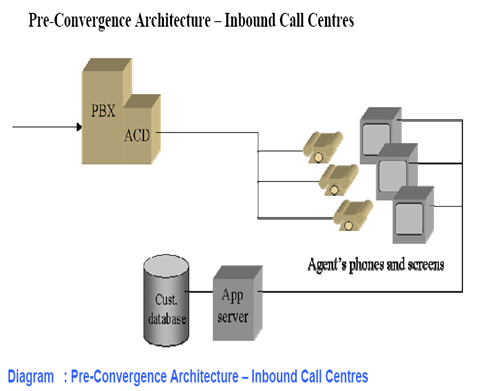
In this Diagram , there is no integration between the telephone system (ie. Private Branch Exchange (PBX)) and the data systems (ie. Customer database and application server). The agents or CSOs answer inbound telephone calls and then use the computer screens to look up information on the customer database. This is known as a “look up and say” system.
There is some basic queue management whereby calls are routed to the nextn available agent by the Automatic Call Distribution system (ACD). This would be configured in the first instance by the PBX installer and the functionality cannot be changed by the users except for the Call Center manager.
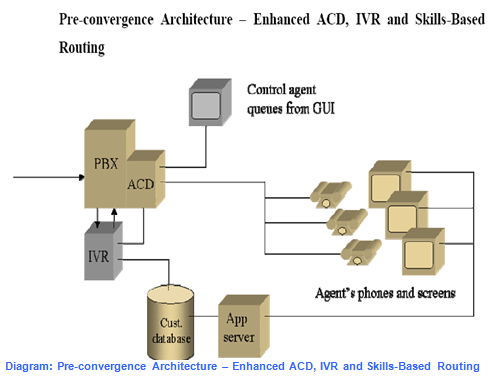
In this model, the role of the Call Centre agent or CSO is beginning to evolve. More experienced or specialized agents/CSO can deal with particular types of call or calls for particular customers. A graphical user interface is attached to the Automatic Call Distributor (ACD) that will allow an administrator to set up priority trees for agents/CSOs based on business rules. For example, a particular group of agents/CSO will deal with complaint calls or a call may be routed to the same agent/CSO who dealt with a customer on their previous call by customising the system.
Some of the functions of the Automatic Call Distributor (ACD):
- • Analyse and distributes high volumes of calls to agents/CSOs and also captures and stores extensive information relevant to those calls – queueto- queue transfer, group and personal call backs;
- • Allows for prioritising of agents/CSOs to deal with overflow situations. Skills-based routing allows calls to be sent to the agent/CSO best suited to deal with the call;Call treatments such as; pre-recorded messages, music on-hold, voice recording etc. will be used in the event of long waits when an agent/CSO is unavailable to attend to a call; and
- • ACD can be coupled with intelligent routers to facilitate virtual Call Centres.
An Interactive Voice Response unit (IVR) can be put into place to field calls that do not require user intervention. An IVR can accept spoken requests as well as input from the keypad, irrespective of who the caller is.
The IVR can also be programmed to deal with different languages and will allow experienced users to interrupt the flow of the interaction to input their responses at any time. The IVR will enable the Call Centre to operate 24 x 7, creating a round-the-clock service to the Public
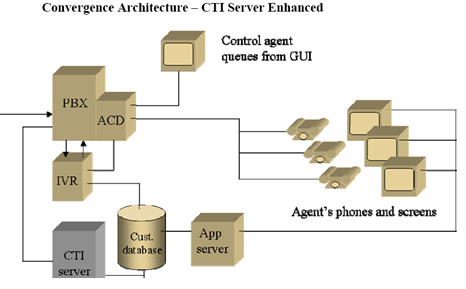
Diagram : Convergence Architecture – CTI Server Enhanced
In This Diagram, a Computer Telephony Integration (CTI) server allows control of telephony devices directly from the PC desktop where telephone controls are built directly into the application.
The key purpose of the CTI server is to deliver customer information to the agent or CSO at the same time the PBX transfers the call to their headset. The PBX uses a method called CLI (Calling Line Identification) or ANI (Actuating Line Identification) to identify the inbound caller. This number is then passed to the CTI server which uses the number to look up the caller’s information in the database.
The call-related information is passed to the application server which “pops” the appropriate screen onto the CSO’s/agent’s workstation at the same time that the ACD places the call to their headsets.
CTI also allows the blending of inbound and outbound calls. The CTI server and ACD can identify CSOs/agents who have been waiting in an inbound queue for a specified period of time. The CTI can then pass an outbound call through to the CSO/agent from the management system. This will help balance the load on the CSOs/agents.
Convergence Architecture – Outbound Call Centres and Campaign
Management
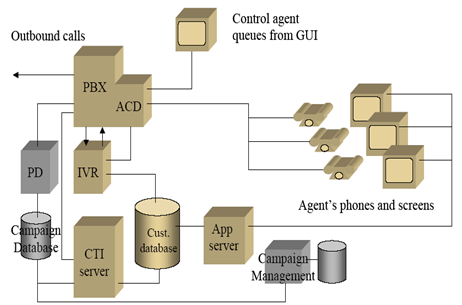
Diagram : Convergence Architecture – Outbound Call Centres and Campaign Management
In this architecture (Diagram 5), predictive or preview dialling are methods used in the management of outbound campaigns. The Predictive Dialler (PD) is fed outbound call lists from a campaign database (possibly a computerised Campaign Management System). The PD makes the calls and when answered, the PD passes the call to the next available agent or CSO. Agents/CSOs do not have to spend time in dialling and waiting for calls, as they are only involved in live calls.
Calls that are answered by a fax, answering machines etc. are logged and withdrawn from subsequent campaigns. Unanswered calls are placed back in the campaign list to be called at a later time.
Rules can also be created which state the number of times a call is placed to a particular number. Numbers can be excluded from campaigns by highlighting it in the campaign database.
Alternatively, in preview mode, the customer information for the next outbound call is popped onto the CSO’s/agent’s screen and the agent initiates the call from an on-screen button.
Convergence Architecture – Virtual Call Centre
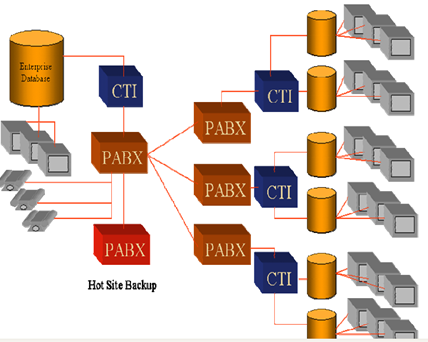
Diagram :Convergence Architecture – Virtual Call Centre
Many organisations now use cross country or global networks, alleviating the need for separate Call Centres in different geographical areas. Smaller, specialized Call Centres can be connected by Wide Area Networks (WANs). This architecture this Diagram is transparent to the caller as all smaller Call Centres’ can be accessed via the same channels. Voice and data can be passed between the Call Centres. This will enable operating hours to be 24 x 7. Disaster or call avalanche strategies can provide for switching functionality between the various Call Centre sites.
Convergence Architecture – Fully Integrated Call Centre
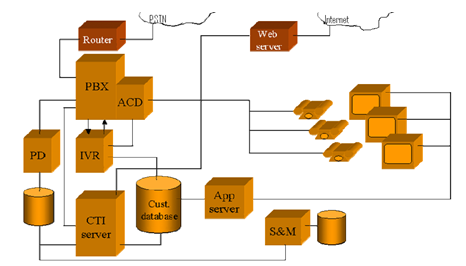
Diagram: Convergence Architecture – Fully Integrated Call Centre
The addition of an intelligent router this Diagram allows both voice and data to be transferred across the Public Switched Telephone Network (PSTN) so that both ICT the voice call and application screens can be passed to remote agents/CSOs, while remaining transparent to the callers.
A web server may facilitate internet telephony (VOIP) so that web based applications can allow users to speak directly to an CSO/agent while browsing through their own on-line details.
Call Centre Implementation Planning
Setting the Objective of the Call Centre
As a Call Centre project without clear objectives tend to encounter major problems, Call Centres must have a set of business objectives, formulated in business terms. These objectives should be formulated before any procurement activity begins. While narrow objectives are easier to address, if the needs are not genuinely narrow, there is no point in forcing them into a narrow definition.
The business plan must also establish sound financial and organization justification for the adoption of such a strategy. This also includes identifying service level objectives, outlining size and site considerations, financial requirements, the extent of organizational process re-engineering and the time frame for implementation.
Sizing the Call Centre
Any organization considering establishing a Call Centre should start by collecting as much data as it can about its existing calls. The estimation of the likely size of a Call Centre is based on:
- • The number, length, timing and subject of phone calls currently received;
- • The estimated increase in these calls when a Call Centre service is introduced;
- • The likely length of calls – for example are the typical interactions with callers likely to be more or less complex than the present;
- • The time staff spend on pre- and post-call activity;
- • The likely staff occupancy;
- • The prospective efficiency gains from dealing with callers in one interaction rather than multiple interactions;
- • Any hourly, weekly or seasonal variation in peak call traffic; and
- • Any other factors pertinent to the implementation of a Call Centre in hand.
Appropriate staffing is one of the most critical aspects in establishing a Call Centre. Ensuring that correct numbers of staff are recruited and deciding on what levels they will be hired are two key decisions in effective human resource management.
Elements of a typical staffing plan include:
- • Determine critical competencies and job standards;
- • Develop position descriptions and person specifications;
- • Set a process for staff selection;
- • Decide on internal or external management of the process;
- • Calculate number of staff initially required;
- • Implement recruitment and selection process; and
- • Design the initial induction-training program.
The number of calls and their duration are the two important factors in determining the staff numbers required in a Call Centre. Estimating call volumes is more difficult in an inbound Call Centre than in an outbound Call Centre. The basic process for estimating staff numbers is as follows:
Step 1 – Determine the number of calls to be made/received;
Step 2 – Determine the average talk time for each call and after-call work time;
Step 3 – Determine the actual productive time of a CSO.
These are some of the definitions used as the basis for the calculations:
- • Call time is the actual call time spent on the telephone;
After-call work time is the time spent on the paperwork or data processing
associated with that call;
- • An average CSO’s day is generally considered to be a six-hour shift or 360
minutes;
- • Average contact time = call time + after-call work time; and
- • Average number of calls per day = 360 average contact time.
The final Call Centre sizing work may require specialist assistance from vendors of automatic call distribution systems who will usually have load simulation capabilities. Nonetheless, the method above produces an estimate; as such, it would still be worthwhile to have contingency plans.
CONCLUSION:
A Call Centre can provide a number of important benefits. First, an increased focus on Public service is likely to lead to more efficient methods in handling significant levels of Public interactions. This, in turn, leads to a reduction in transaction costs where the majority of simple customer interactions are handled by dedicated, well-trained, frontline staff. The more senior and experienced staff can then be assigned to more complex tasks.
Achieving further internal efficiencies may also allow the agency to initiate contacts with clients and can streamline the handling of incoming calls to a central area, rather than being spread across various sections throughout the agency. By replacing over-the-counter transactions with telephone contacts, agency and Public costs, alike can be reduced. As long as telephone contacts are handled efficiently, members of the public who do not have time for, or access to, face-to face transactions will view the change favorably. In establishing a Call Centre, a business plan needs to be developed with the Call Center’s objectives defined. In supporting the Call Center’s objectives, it is imperative that good Call Centre Operations Management practices are employed. Human Resources resides as one of the key factors for Call Centre Operations management. It encompasses 65% of the Call Center’s operating expenditure that makes it an important factor in the overall success of the Call Centre. Hence, without structured development programs and retention schemes, the Call Centre expertise can diminish together with the overall objectives of the Call Centre.





